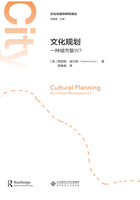
图
1.1 文化资源规划前景(Cultural resources planning perspective),12页。
4.1 两个词的文字游戏:艺术中心(Word game take two words:arts centre),150页。
5.1 根据社会等级的英国艺术参加者概况(1996)(Profile of arts attenders in Britain by social grade,1996),178页。
5.2 艺术参与者与使用者之间的知识差距(Knowledge gap between arts participants and “non-users”),183页。
5.3 鼓励人们待在家里的问题(Issues encouraging people to stay at home),186页。
5.4 需要的设施:距离关系(Facilities needed:distance relationships),190页。
5.5 艺术供给层次结构和机会金字塔(Hierarchy of arts provision and the pyramid of opportunity),192页。
5.6 艺术设施规划(Arts facility planning),193页。
6.1 旅游历史城市资源的休闲用户和用途的一些关系(Some interrelationships of recreational users and uses in the touristic-historic city),221页。
6.2 英国休闲消费的增长——在家与外出(1979—2001)(Growth of UK leisure spending—in-home and away,1979—2001),224页。
6.3 英国部门的创意产业就业和离职情况(Creative industries employment and turnover by UK sector),241页。
6.4 巴黎电影制作公司的位置(Location of film production companies in Paris),255页。
6.5 巴黎创意人才与角色分配机构的位置(Location of creative talent and casting agencies in Paris),255页。
8.1 新加坡中心区:选定的艺术基础设施和文化遗产区(Singapore's Central Area:selected arts infrastructure and cultural-heritage districts),355页。
9.1 战略和规划之间的联系(Linkages between strategies and plans),415页。